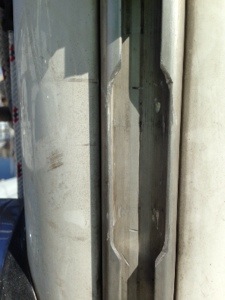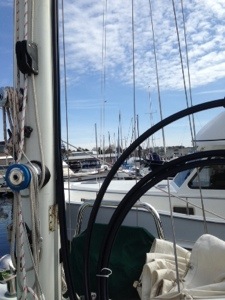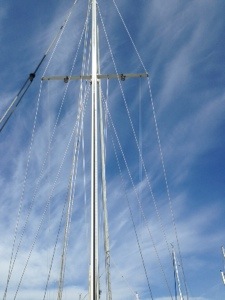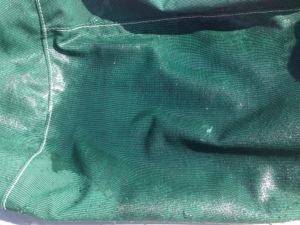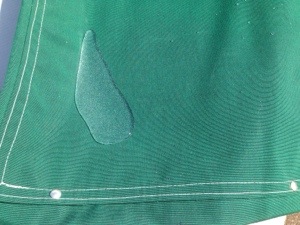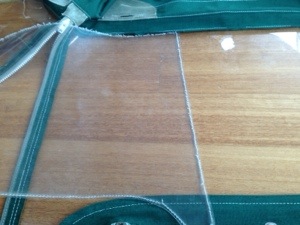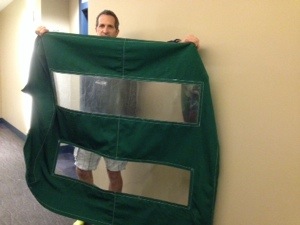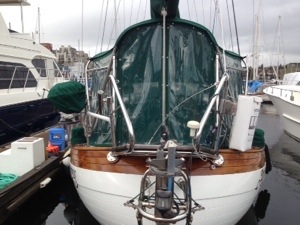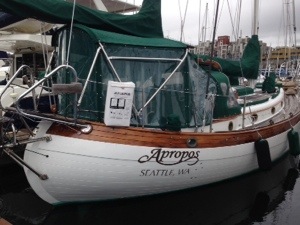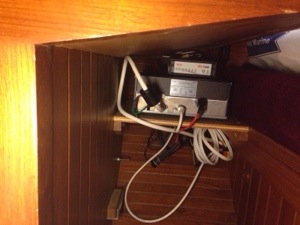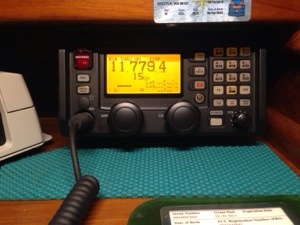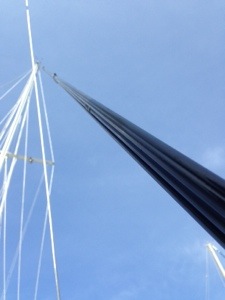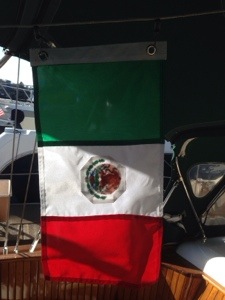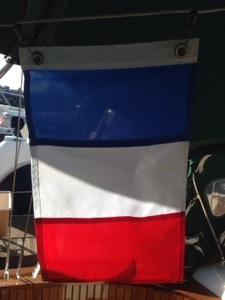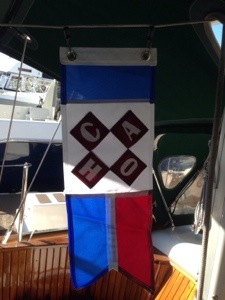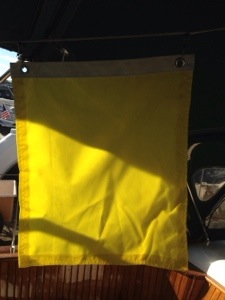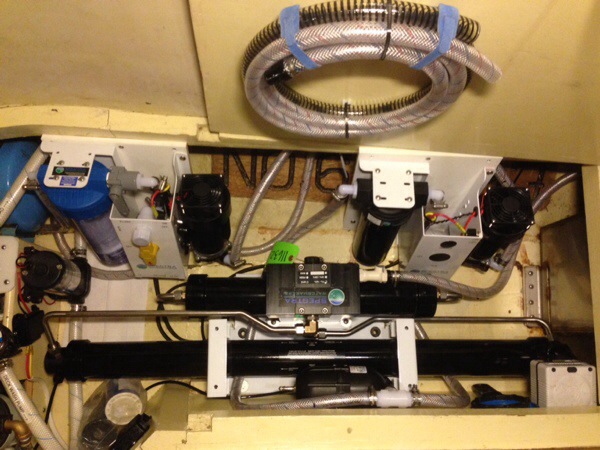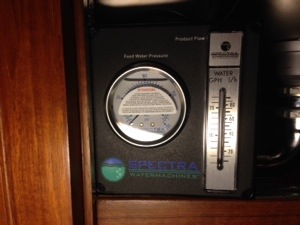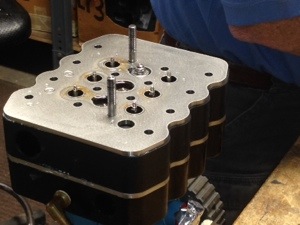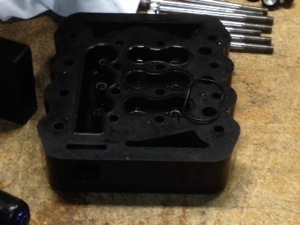The new mainsail is being fitted with new slides made from 316 stainless that fit into a UHMW track (ultra-high molecular weight which is very strong and abrasion resistant) that slides into the original mast luff groove. This system by Tides Marine lowers the friction and makes it easier to raise and lower the mainsail. I installed the one-piece track by first cutting a new slot in the aluminum mast groove using a dremel tool with cutting discs. Next, the new track, which came in a big roll, was fed into the slot and slid all the way to the top of the mast. I had to remove the boom so there would be no angle when feeding the track up. This was an easy project that took about 3 hours.
Category Archives: Projects
Canvas and Dodger Windows
Canvas–I washed and treated all the boat Sunbrella canvas. I have a ton of canvas–a full boat cover, 2 boom sail covers, a dodger, 2 deck box covers, helm seat cover, binnacle cover, 2 winch covers, 4 grab rail covers, 2 hatch covers, 2 stantion covers, and a BBQ cover. Most of the canvas is 10 years old but in pretty good shape, so they’re worth taking care of. The wash was done using Simple Green diluted to a medium strength and just a small amount of clorox cleanup. A light scrub with a stiff bristle brush helped remove some of the dirt and mildew. After rinsing and letting them dry well in the sun, I sprayed a waterproofing material on them using a small pump type garden sprayer. I used a product by Gold Eagle called 303 Fabric Guard that was given a best rating by Practical Sailor magazine and is endorsed by Sunbrella. It’s not cheap at $75/gal (and I went through 4 gallons!), but the results turned out great. After years in the Seattle rain, the canvas wasn’t repelling water like when it was new. Now the water beads up and runs right off. I’ll have to see how long it stays that way and decide how ofter to repeat the treatment. Shown below are photos of untreated canvas (top) and treated canvas (bottom) that were sprayed with water.
Dodger Windows–The dodger was brand new when I bought the boat 10 years ago and is still in good shape. But the vinyl windows have become scratched and are not nearly as clear as they were 10 years ago, so I decided to replace them. I used double polished 40 mil vinyl by Regalite, which is the same as the original. The procedure was to first cut the new vinyl the same shape as the old. Next remove the outside stitching and trim back the old vinyl to the inside stitching. Then sew in the new vinyl with the outside stitch. Next remove the inside stitch which will allow the old vinyl to be completely removed. Finally sew the inside stitch and you’re done. This procedure ensures the dodger will keep the same shape when all done (removing the old vinyl first would make it nearly impossible to keep the dodger shape the same). The dodger consisted of 3 large forward facing windows and 2 small side windows. This project turned out to be very time consuming but we’re pleased with the results. Here’s a picture of the old and new vinyl:
.
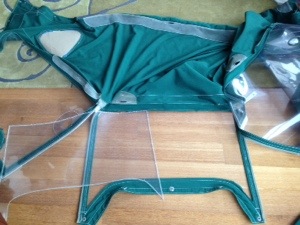
I also replaced the vinyl on the butterfly hatch cover. Here’s when it was half done showing the difference between the new (bottom) and old (top).
New Bimini and Cockpit Enclosure
We decided to add a bimini for sun protection in the tropics and rain protection in the Pacific Northwest. Since we were able to see 2 of these installed on other Hans Christians and they were both Iverson designs, it was an easy decision to go with them. We also chose to have mesh-screen panels added to give the cockpit a full-enclosure. This also provides more shade from the sun while still allowing good visibility as well as air flow. The enclosure comes as 6 zip-on panels so various combinations can be used. A connector panel ties the bimini into our dodger. We made our own snap-on vinyl panels for keeping out the rain and wind. With the full enclosure and vinyl panels in place, the cockpit becomes an additional “room” during the winter months in Seattle. Even on a cold winter day, the sun warms the cockpit with the full enclosure in place.
Installation–I met the Iverson crew at the boat to go over the design. The biggest decision was the height of the bimini. The mizzen boom would need to be raised to allow clearance above the bimini AND I wanted the bimini high enough for me to be able to stand at the helm without ducking. This required me to move the boom up by about 13″. We also added a zipper onto the front edge of the dodger for the connector panel. This was all done before Iverson came back to begin building the bimini. They first built the custom stainless steel frame which they cut/bent/adjusted/installed on-site. Then they took measurements and returned a few weeks later with the canvas and mesh panels and everything fit perfectly.
Vinyl Panels–We decided to make our own vinyl panels. Instead of making separate panels to take the place of the mesh panels, we built the vinyl panes slightly small than the mesh panels and added snaps to make them easy to put on and take off. We used 30 mil vinyl and trimmed the edges with canvas. I did all the prep work (measuring, cutting, taping on the canvas binding) and Karen did all the sewing, using the “Beast”
(our Sailrite industrial-grade sewing machine). Then I took the 6 panels to the boat, removed the mesh panels, and hammered on the snaps. It was time consuming work but we were pleased with the results. Now I can sit in the cockpit playing guitar during a downpour!
Bimini and Full Enclosure w/ Vinyl Panels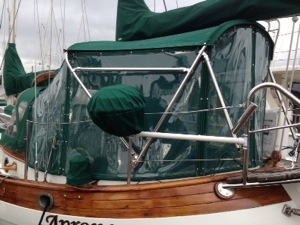
Single Side Band Radio
I bought the ICOM IC-802 SSB radio at the 2012 Seattle Boat show. The package came with an auto-tuner AT-140, a GAM split lead antenna, a KISS counterpoise, and an SCS Pactor III modem.
Installation–Figuring out where to place the components was an important first step. Since the radio itself could be tucked away, I built a shelf for it under the nav station chart table. The remote display fit along side the chartplotter at an angle for easy viewing and tuning. I mounted the speaker higher up in against the bulkhead. Since the tuner wants to be as close to the antenna as possible, I found a place inside the transom that would be only a few feet from the antenna. The GAM split lead antenna has a split tubing that was easy to slide up a long side-stay with zip ties used every few feet. Lastly, the KISS counterpoise was run from the tuner under the starboard bunk. The Pactor modem easily fit atop the radio making it easy to connect to a laptop at the nav station. This installation kept everything relatively close together on the starboard side. Power to the radio was run from the DC panel using #8 AWG wire and a 30A breaker.
Testing–It’s hard to really test the SSB on a lake in the middle of the city. Interference, weather, and atmospheric conditions come into play with transmitting and receiving signals. At the marina, I was able to receive signals from far away (different languages) but couldn’t really test my transmitting capability. I did notice strange things happened when I keyed the mic to transmit–lights dimmed and some breaker panel lights turned on. I read this is normal and signifies you are sending some high power signals out. More experimentation is needed when I’m outside the city in more open water.
Sailmail–Sailmail
Flags
Another one of Karen’s side projects is making flags. My only job was to hammer on the grommets.
I used flagcloth polyester material, flagtape on the sides and fabric pens for the designs.
Here are some we hope to use on our trip (click on flag to identify):
I have to say that I had the most fun designing the French Polynesia Flag, which I found out is not a courtesy flag in French Polynesia. The official courtesy flag is the French Tricolour. To get the design on the white portion of the flag I printed out a copy of the design and traced and coloured in the design using fabric pens directly.
For the Mexican Flag, which was my first attempt, I traced two designs onto white fabric patches and sewed them onto the flag. This design was so intricate I was afraid of making a permanent mistake if I traced it directly onto the fabric.
Spectra Watermaker
I bought a Spectra Cape Horn watermaker at the 2014 Seattle Boat Show. I chose the Cape Horn because of its simplicity (manual control) and built-in redundancy (can run off 1 of the 2 pumps). With both pumps running, it can produce 14GPH at 18A (or 1.3 Ahrs/gal).
Installation–The Cape Horn is a modular system. The 3 largest components are the Clark pump/membrane, filter/pump1, and filter/pump 2. There’s also an accumulator tank, remote monitoring panel, product water valve, and test port to install. I had only a few options for the install location. Under the V-berth or under the port-side settee. Since accessibility is important for changing filters and throwing manual valves, I decided under the port-side settee would be the best location. The largest module (Clark pump) just fit after relocating a deck wash pump. The two filter/pump modules were slightly too tall so I modified a few hose fittings to allow them to fit within the available height and mounted them securely on starboard. I ran about 30′ of #4 AWG wire from the watermaker to a 30A breaker on my DC panel. I installed a brass spout at the galley sink for testing the product water and filling drinking bottles. Also in the galley is a valve for selecting the sink spout or the forward 60 gallon tank for product water. I installed a Tee in the sea water input hose for the head and piped the brine water output to the head sink drain. I also Tee’d into the pressure fresh water for the flush cleaning input. For filling the water tank, I drilled and tapped a hole in the top of the SS tank and installed a Parker fitting. The Parker fittings and 1/4″ tubing used on the product water side were easy to work with. The most difficult was running the 5/8″ tubing to the head and tying it into the 1-1/2″ sink drain. Since I couldn’t find an ideal place to mount the remote monitoring panel that didn’t require cutting into teak, I decided to mount it inside the galley engine access door. This was a convenient place since the valve was also mounted in that area. The panel has a flow rate gauge and a pressure gauge that should be monitored from time to time.
Monitor Gauge and Manual Valve
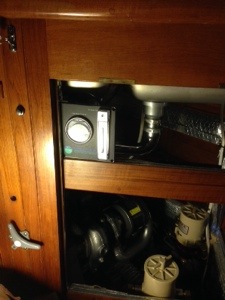
Watermaker Output to SS Water Tank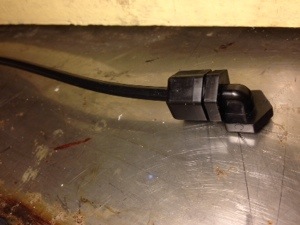
Brine Discharge to Head Sink Drain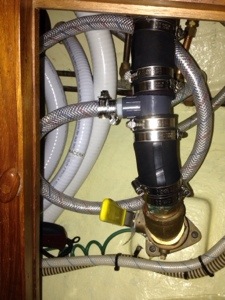
Video Showing Clark Pump Operating
Mast steps
To make it easier to inspect and work on the main masthead, I installed two folding steps about 4 feet below the top of the mast. I’m building a 3:1 system from Harken hexaratchet blocks to be able to pull myself up. Once up there I will be able to stand on the steps, tie off, and work at chest level to inspect, change anchor bulbs, VHF antenna, windvane, etc. Trying to do this from a bosun chair is difficult because you’re working above your head and can’t see the very top. First project will be to change the anchor bulb to LED.
Installing AIS Transceiver
An Automatic Identification System (AIS) is an electronic device that allows you to see other vessels (who also have AIS) on a chartplotter. Ships and ferries are required to have AIS, and it’s becoming more common for smaller vessels. AIS for smaller vessels comes in two types–receive only that allows you to see others, and transmit/receive that allows you to see other and for them to see you. AIS uses a combination of GPS and VHF to transmit and receive information. A chartplotter will display a triangular mark for each vessel it is receiving a signal from. Selecting a mark then brings up a screen showing information such as vessel name, home port, vessel speed and for ships, it shows what cargo it’s carrying.
The main reasons for having AIS aboard is for safety. It’s kinda like an modern form of radar since it allows you to see other vessels electronically. Radar of course also allows you to see land and rain squalls. We’ve been in thick fog where we relied on our radar to locate ships that were blasting foghorns. Having a more accurate system at the helm will add redundancy and safety. Also, on ocean passages the AIS can be used as a warning to sound an alarm when a vessel broadcasting AIS gets within a certain distance.
I decided on a class B AIS from West Marine that transmits and receives information. It has a “silent” button on the case that allows you to silence the transmit function. The installation involved lots of wiring–coaxial wire to a VHF antenna (fortunately my boat had a spare VHF antenna installed on the main mast with the wire coiled and labeled in the bilge–shows somebody was thinking ahead!), a cable to a GPS antenna (not sure where I will mount this antenna yet), PWR/GND wires to the electrical panel, and 2 strands on NMEA cable to the chartplotter. I decided to tie the AIS into the Garmin chartplotter at the helm. When I installed the cable for this chartplotter, I ran the data cables near the electrical panel so they will be easy to get to.
New Dickinson Stove
Finished installing the new Dickinson 3-burner Mediterranean propane stove. This replaced an older HilleRange model that now sits at Second Wave Marine, a consignment boating store. The new Dickinson is 100% stainless steel, has dual 7000 BTU burners and 1-11000 BTU stove burner. The oven is larger than our old one and has a7000 BTU burner plus a 4500 BTU broiler. Other features: electronic ignition (no more matches!), gimbaled mount kit, safety flame-out protection, removable cutting-board on top, and pot-holders. The hardest part of the installation was fitting it through the companionway since it was both heavy and bulky. There was about 1″ of clearance!
For photos, see “Latest Pics from my iPhone”
Fleming Wind Vane
A Fleming mechanical self-steering wind vane came with Apropos and has been kept in my garage the past 4 years. It’s an older model built in the 1980’s, but appears to be in great shape. The system is a bulky stainless steel mechanical marvel that weighs a ton. It attaches to the stern with 4 struts and its purpose is to steer the boat in a desired direction using only the wind. It has a wind vane, a small rudder attached to a pendulum, and a drum that connects to the wheel. Once the boat is heading in a desired direction with respect to the wind, the pendulum will make adjustments to the wheel whenever the heading (with respect to the wind) changes. A linkage (two 6 mil nylon lines) goes from the pendulum to a wheel adapter, which is a drum fastened to the wheel. The drum is wrapped 3-4 times with 8 mil nylon rope that has eyes on both ends. These systems are very helpful for offshore cruising so you don’t have to sit behind the wheel hand steering all the time. I recently took the system apart and freed the toothed adjusting disc that had seized from years of sitting around. It took lots of WD-40 solvent and some time before it finally turned easily. The only piece I believe is missing is the drum that connects onto the wheel. Tonight I finally got thru to Fleming (based in Australia) and ordered a new stainless steel wheel adapter and a storm vane (a smaller wind vane used when the wind is really blowing). Both will be shipped to Sydney since we’re going there in a few weeks. They were $643 AUS including shipping. I plan on hooking it up to Apropos this summer and trying it out during our trip to the Gulf Islands in August.
